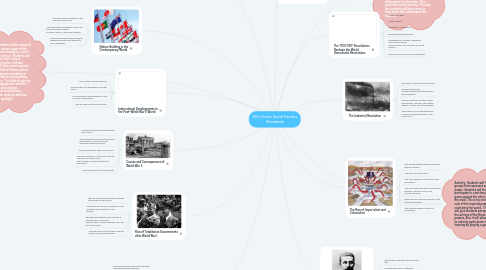10th Grade Social Studies Standards
Christopher Anagnostouにより

1. Effects of World War I
1.1. How did World War I end? What were the consequences of the postwar agreement?
1.2. How did agreements dating from the World War I and postwar periods impact the map of the Middle East?
1.3. What were the effects of World War I on ordinary people?
1.4. Why does the term “lost generation” refer to those who lived through or came of age during these years?
1.5. How did the post-World War I world order contribute to the collapse of the worldwide economy?
2. Rise of Totalitarian Governments after World War I
2.1. Why did communism and fascism appeal to Europeans in the 1930s?
2.2. What were key ideas of communism? How were the ideas translated on the ground?
2.3. What was totalitarianism, and how was it implemented in similar and different ways in Japan, Germany, Italy, and the Soviet Union?
2.4. How did Nazis come to power? Why did ordinary people support them?
3. Causes and Consequences of World War II
3.1. Why was the death toll so high during World War II?
3.2. What were the key goals of the Axis and Allied powers? How was the war mobilized on different fronts?
3.3. How did technology affect World War II?
3.4. How was World War II a total war? How did World War II’s actors, goals, and strategies compare with those of World War I?
3.5. How was the Holocaust carried out?
4. International Developments in the Post–World War II World
4.1. How did the Cold War develop?
4.2. How was the Cold War waged all over the world?
4.3. How did former colonies respond to the Cold War and liberation?
4.4. How and why did the Cold War end?
5. Nation-Building in the Contemporary World
5.1. How have nations organized in the post–Cold War world?
5.2. How have nations struggled in similar and different ways to achieve economic, political, and social stability?
5.3. How have developing nations worked together to identify and attempt to solve challenges?
6. Economic Integration and Contemporary Revolutions in Information, Technology, and Communications
6.1. How has globalization affected people, nations, and capital?
6.2. How has the post–Cold War world and globalization facilitated extremist and terrorist organizations?
7. Activity- Students will be assigned to different nations apart of the United Nations during key events during the cold war. Students will then research their nations interests during the cold war. Students will then come together for a mock United Nations where they will simulate a meeting at the United Nations representing their country. This kind of activity promotes engagement with the students. It also contains elements that would allow a variety of the students skills too shine in the spotlight.
8. Activity- Students will be given multiple primary sources of philosophers that had an impact on the development of new ideas during the age of enlightenment. Each group will study a different philosopher's writing. Then the students will present their philosopher too the class. This promotes active learning. This way the students will learn more as they teach their classmates the material.
9. The 1750-1917: Revolutions Reshape the World Democratic Revolutions
9.1. Enlightened Ideas
9.2. Social Contract
9.3. Individual or natural rights
9.4. Representative governments
9.5. Consequences of trying to implement political revolutionary ideas in Europe, Latin America, and North America
9.6. French, American, and Haitian Revolutions
10. The Industrial Revolution
10.1. The results of the industrial revolutions
10.2. How was technology, and the environment transformed by industrialization?
10.3. How did industrial revolutions affect governments, countries, and national identity in similar and different ways?
10.4. Should this era of industrialization be called an Industrial Revolution? Why or why not?
11. The Rise of Imperialism and Colonialism
11.1. Why did industrialized nations embark on imperial ventures?
11.2. How did colonization work?
11.3. How was imperialism connected to race and religion?
11.4. How was imperialism similar and different between colonies in Africa, Asia, and Latin America?
11.5. What were the causes and effects of the Mexican Revolution?
11.6. How did native people respond to colonization?
12. Causes and Course of World War I
12.1. Why did the Great War become a World War?
12.2. How was World War I a total war?
12.3. What were the consequences of World War I for nations and people?
12.4. Why did the Russian Revolution develop, and how did it become popular?
13. The World in 1750
13.1. How were most societies organized in the 1700s?
13.2. Who held power in the 1700s? Why?
13.3. What was the divine right of kings?
14. Activity- Students will form into groups that represent an Imperial power. Students will then participate in a territory claiming game against the other groups in the class. This is too simulate the rush of the imperial powers colonizing the world. This activity will give students perspective on the actions of the these imperial powers. Also it will allow students to actively participate in their learning by playing a game.


